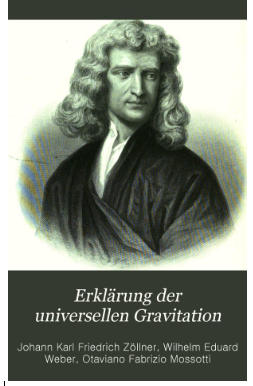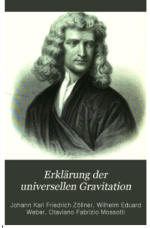












Explanation of universal gravitation
or from Newton to Mossotti to Weber
Johann Carl Friedrich Zöllner


Modern atomic physics has pushed science away from the materialistic direction it had taken in the 19th century.
Werner Heisenberg


When Newton formulated his principles, he realized that he was describing only one force, the force with which the apple falls from the tree. However, he was unable to describe why the moon does not fall on the earth but revolves around the earth.
He left it up to his readers to decide whether it was a material or immaterial force.
The science of the enlightened 19th century in Europe then developed electrodynamics as the material answer to Newton's problem. The Italian Mossotti was the first to recognize that this force arose from the different electrical polarities of atoms and molecules. Wilhelm Weber described this electrostatic force. But it was not until the end of the 19th century that the question of this force was fully answered by Tompson and Lorentz. It was called the Lorentz force. In this days all electric motors work with this power.
A caesura in the history of physics began when disputes within the church about the compatibility of science and faith began at the end of the 19th century.














Explanation of universal gravitation
or from Newton to Mossotti to Weber
Johann Carl Friedrich Zöllner
Modern atomic physics has pushed science away from the materialistic direction it had taken in the 19th century.
Werner Heisenberg


When Newton formulated his principles, he realized that he was describing only one force, the force with which the apple falls from the tree. However, he was unable to describe why the moon does not fall on the earth but revolves around the earth.
He left it up to his readers to decide whether it was a material or immaterial force.
The science of the enlightened 19th century in Europe then developed electrodynamics as the material answer to Newton's problem. The Italian Mossotti was the first to recognize that this force arose from the different electrical polarities of atoms and molecules. Wilhelm Weber described this electrostatic force.






























